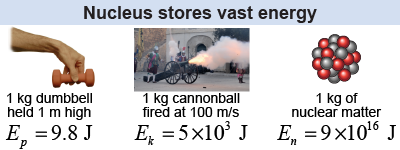|
You may have heard Einstein’s equation many times, but did you ever stop to think about what it means? The equation, which relates energy, mass, and the speed of light, is a succinct statement of a powerful concept: that mass can be converted into pure energy and vice versa. This mass–energy equivalence is at the heart of nuclear physics and its applications, such as nuclear power generation. Equation (27.1) describes exactly how much mass is associated with a given amount of energy and how much energy it takes to create a given amount of mass. 
|
| (27.1) | | | E | = | energy (J) | | m | = | mass (kg) | | c | = | speed of light = 3×108 m/s |
| Mass-energy equivalence
|
|
Einstein’s equation tells us how much rest energy is contained in matter itself. All matter has rest energy even if the matter has no kinetic energy, potential energy, thermal energy, or any other type of energy we have discussed. Rest energy is intrinsic to matter itself. Whether the matter is stopped or moving, matter itself is energy and energy is matter. 
|
 The factor c2 is an enormous number: c2 = 9 × 1016 m2/s2. Matter contains vast quantities of rest energy through the mass–energy equation. Nuclear reactions convert some of the rest energy into other forms of energy, such as heat. When one kilogram of uranium reacts in a nuclear power plant, about 0.7% of its mass is converted to energy. This tiny fraction is more than a million times more energy than burning one kilogram of coal or oil.
The factor c2 is an enormous number: c2 = 9 × 1016 m2/s2. Matter contains vast quantities of rest energy through the mass–energy equation. Nuclear reactions convert some of the rest energy into other forms of energy, such as heat. When one kilogram of uranium reacts in a nuclear power plant, about 0.7% of its mass is converted to energy. This tiny fraction is more than a million times more energy than burning one kilogram of coal or oil. 
|
Nuclear scientists often express mass in energy units based on equation (27.1). The atomic mass unit (amu) corresponds to a mass of 1.661×10−27 kg. The energy equivalent of 1 amu is calculated from Einstein’s relationship: E = mc2 = (1.661 × 10−27 kg) × (2.998 × 108 m/s)2 = 1.493 × 10−10 J The energy unit used in nuclear physics is the electron volt (eV). One eV corresponds to 1.602 × 10−19 J (page 763). Therefore, in energy units, which is 931.5 million eV or 9.315 × 108 eV. 
|
What is the difference in rest energy between a neutron and a proton? (The masses of the neutron and proton are mn = 1.675 × 10−27 kg and mp = 1.673 × 10−27 kg, respectively.) | Asked: | difference in rest energy | | Given: | mass of the neutron, mn = 1.675 × 10−27 kg;
mass of the proton, mp = 1.673 × 10−27 kg | | Relationships: | E = mc2; speed of light, c = 2.998 × 108 m/s | | Solution: | The difference in the two particle’s rest energies is the difference between their two masses multiplied by c2:
ΔE = (Δm)c2 = (1.675−1.673)×(10−27 kg)×(2.998×108 m/s)2 = 1.8×10−13 J | | Answer: | 1.8 × 10−13 J | 
|
What is the energy equivalent of a proton at rest? Give the answer in joules and electron volts.
 |
The rest mass of the proton is m = 1.673 × 10−27 kg. The energy equivalent is calculated from Einstein’s relationship: In electron volts the energy is (1.504 × 10−10 J) / (1.602 × 10−19 J/eV) = 938.8 × 106 eV = 938.8 MeV 
|

